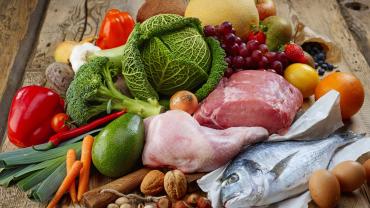As a healthcare professional you are likely familiar with the myriad benefits of a Paleolithic-style diet. Eliminating refined sugars and grains dairy and legumes has been reported to benefit such wide-ranging health concerns as acne rheumatoid arthritis metabolic syndrome type 2 diabetes dyslipidemia cardiovascular health and more. Even in the absence of whole grains dairy and legumes—some of which have been consumed by healthy populations for centuries—modern diets based on foods that fit a Paleo template are nutrient dense and typically have a far lower glycemic load than the carbohydrate-heavy modern American diet.
The stunning turnarounds in health many people have experienced by transitioning to a Paleo diet have brought this nutritional strategy a great deal of attention in the past few years. More and more people are gradually adopting some of the tenets even if they’re not going full-bore Paleo. And while there’s nothing wrong with consuming high quality animal proteins (such as beef lamb shellfish and organ meats) lots of green and colorful vegetables fruit and nuts Paleo is not without its pitfalls. In falling into some of these traps patients who adopt a Paleo diet may not get the life-altering results they’ve read about.
Here’s a quick guide to some of the issues patients should be mindful of as they either make a shift toward this way of eating or troubleshoot why they haven’t experienced the benefits they were hoping for despite eating a Paleo diet for some time.
- Paleo treats: gluten-free artisanal junk food is still junk food. Yes sweets and treats made with almond flour maple syrup raw honey cocoa powder and coconut oil may provide more nutrients than their conventionally produced counterparts but that doesn’t negate their heavy load of simple carbohydrates. Organic unrefined sugars are still sugars and it’s all too easy to rack up calories from cookies cakes and muffins made with arrowroot starch dates and butter from grass-fed cows. While an occasional treat is perfectly fine one of the goals of a Paleo diet is to break people of sugar addiction altogether so that they don’t “need” to replace old favorites with Paleo-compliant versions that really aren’t much healthier than the mass-produced brands.
- Too much bacon (and other meats & fats): Paleo-style eating appeals to many former vegans vegetarians and low-fat dieters for whom bacon and other fatty animal foods were verboten for many years. Upon suddenly being “allowed” to consume well-marbled steaks and pork chops with a nice fat cap they may go a little too far in the other direction. Not that there’s anything wrong with eating meat and saturated fat (although the truth is pork & beef are actually high in monounsaturated fats) but these shouldn’t be consumed to the exclusion of the many other foods that are Paleo-friendly such as a rainbow of vegetables and seafood nuts and seeds to provide a host of other nutrients and diverse fatty acids. Additionally those who adopt a Paleo diet with the goal of weight loss may find their total calories skyrocketing if they go overboard on fatty foods particularly if they’re following a higher-carb Paleo diet and combining an increased fat intake with starchy veggies such as yams.
- Orthorexia: When people begin to learn the truth about vegetable oils and refined sugars it’s easy to take things too far in pursuit of food purity and “clean eating.” An unwavering dedication—or rather obsession—with dietary sainthood may interfere with social engagements and relationships when people let their self-imposed food restrictions determine what where and when they can eat. This differs of course from individuals with severe allergies or intolerances to specific foods or compounds such as gluten dairy or nightshades. In these cases people do need to be constantly vigilant to avoid cross-contamination and unwittingly consuming something that may cause a harmful reaction. However those who follow a Paleo diet for the general health benefits but who have no known food sensitivities may become overly worried about the provenance of their food to the point that they alienate friends and loved ones and avoid social events for fear of eating something “off-plan.” Following a Paleo diet is supposed to make life more enjoyable not less. Many people without overt food sensitivities find they do just great with the “80/20 rule” – eating well 80% of the time and allowing a little wiggle room here and there for a slice of birthday cake grandma’s famous apple pie or yes maybe even a stress-dissolving donut during a meeting at work.
- Thinking that the diet is enough: Adopting a Paleo diet will take people very far in terms of improved health and wellbeing. But there are a host of other non-nutritional inputs that contribute to overall wellness of “the whole person.” It would be nice if improving one’s diet bled over into other aspects of their life: ditch the grains refined sugars and vegetable oils and all of a sudden they love their job or have deeper social connections. Often this does happen but following a Paleo diet isn’t a magical elixir to automatically fix other aspects of life. A Paleo diet—or rather a focus on health through an evolutionary or ancestral framework—may introduce people to the importance of sleep quality and quantity time spent outdoors in nature physical movement and human connection. The diet is a good place to start but it’s not the place to stop.
The good news is these pitfalls that newbies and old hands alike may find themselves sliding into are quite easily remedied. All it takes is awareness…and going easy on the bacon.
